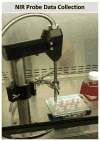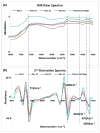Nondestructive Assessment of Engineered Cartilage Composition by Near Infrared Spectroscopy
- PMID: 26817457
- PMCID: PMC4792783
- DOI: 10.1007/s10439-015-1536-8
Nondestructive Assessment of Engineered Cartilage Composition by Near Infrared Spectroscopy
Abstract
Tissue engineering presents a strategy to overcome the limitations of current tissue healing methods. Scaffolds, cells, external growth factors and mechanical input are combined in an effort to obtain constructs with properties that mimic native tissues. However, engineered constructs developed using similar culture environments can have very different matrix composition and biomechanical properties. Accordingly, a nondestructive technique to assess constructs during development such that appropriate compositional endpoints can be defined is desirable. Near infrared spectroscopy (NIRS) analysis is a modality being investigated to address the challenges associated with current evaluation techniques, which includes nondestructive compositional assessment. In the present study, cartilage tissue constructs were grown using chondrocytes seeded onto polyglycolic acid (PGA) scaffolds in similar environments in three separate tissue culture experiments and monitored using NIRS. Multivariate partial least squares (PLS) analysis models of NIR spectra were calculated and used to predict tissue composition, with biochemical assay information used as the reference data. Results showed that for combined data from all tissue culture experiments, PLS models were able to assess composition with significant correlations to reference values, including engineered cartilage water (at 5200 cm(-1), R = 0.68, p = 0.03), proteoglycan (at 4310 cm(-1), R = 0.82, p = 0.007), and collagen (at 4610 cm(-1), R = 0.84, p = 0.005). In addition, degradation of PGA was monitored using specific NIRS frequencies. These results demonstrate that NIR spectroscopy combined with multivariate analysis provides a nondestructive modality to assess engineered cartilage, which could provide information to determine the optimal time for tissue harvest for clinical applications.
Keywords: Cartilage; Collagen; Multivariate data analysis; Near infrared spectroscopy; Proteoglycan; Tissue engineering.
Conflict of interest statement
The authors of this manuscript report no conflict of interests related to the work presented here.
Figures






Similar articles
-
Applications of Vibrational Spectroscopy for Analysis of Connective Tissues.Molecules. 2021 Feb 9;26(4):922. doi: 10.3390/molecules26040922. Molecules. 2021. PMID: 33572384 Free PMC article. Review.
-
Near infrared spectroscopic assessment of developing engineered tissues: correlations with compositional and mechanical properties.Analyst. 2017 Apr 10;142(8):1320-1332. doi: 10.1039/c6an02167k. Analyst. 2017. PMID: 27975090 Free PMC article.
-
Near-Infrared Spectroscopy Predicts Compositional and Mechanical Properties of Hyaluronic Acid-Based Engineered Cartilage Constructs.Tissue Eng Part A. 2018 Jan;24(1-2):106-116. doi: 10.1089/ten.TEA.2017.0035. Epub 2017 May 15. Tissue Eng Part A. 2018. PMID: 28398127 Free PMC article.
-
Approaches for In Situ Monitoring of Matrix Development in Hydrogel-Based Engineered Cartilage.Tissue Eng Part C Methods. 2020 Apr;26(4):225-238. doi: 10.1089/ten.TEC.2020.0014. Epub 2020 Apr 3. Tissue Eng Part C Methods. 2020. PMID: 32131710 Free PMC article.
-
Nondestructive Techniques to Evaluate the Characteristics and Development of Engineered Cartilage.Ann Biomed Eng. 2016 Mar;44(3):733-49. doi: 10.1007/s10439-015-1535-9. Epub 2016 Jan 27. Ann Biomed Eng. 2016. PMID: 26817458 Free PMC article. Review.
Cited by
-
Near-Infrared Spectroscopy Enables Arthroscopic Histologic Grading of Human Knee Articular Cartilage.Arthrosc Sports Med Rehabil. 2022 Aug 20;4(5):e1767-e1775. doi: 10.1016/j.asmr.2022.07.002. eCollection 2022 Oct. Arthrosc Sports Med Rehabil. 2022. PMID: 36312728 Free PMC article.
-
Applications of Vibrational Spectroscopy for Analysis of Connective Tissues.Molecules. 2021 Feb 9;26(4):922. doi: 10.3390/molecules26040922. Molecules. 2021. PMID: 33572384 Free PMC article. Review.
-
Rapidly Simultaneous Determination of Six Effective Components in Cistanche tubulosa by Near Infrared Spectroscopy.Molecules. 2017 May 19;22(5):843. doi: 10.3390/molecules22050843. Molecules. 2017. PMID: 28534831 Free PMC article.
-
Raman spectroscopic imaging for quantification of depth-dependent and local heterogeneities in native and engineered cartilage.NPJ Regen Med. 2018 Feb 9;3:3. doi: 10.1038/s41536-018-0042-7. eCollection 2018. NPJ Regen Med. 2018. PMID: 29449966 Free PMC article.
-
Non-Destructive Spectroscopic Assessment of High and Low Weight Bearing Articular Cartilage Correlates with Mechanical Properties.Cartilage. 2019 Oct;10(4):480-490. doi: 10.1177/1947603518764269. Epub 2018 Apr 24. Cartilage. 2019. PMID: 29690771 Free PMC article.
References
-
- Afara I, Prasadam I, Crawford R, Xiao Y, Oloyede A. Non-destructive evaluation of articular cartilage defects using near-infrared (NIR) spectroscopy in osteoarthritic rat models and its direct relation to Mankin score. Osteoarthr Cartil. 2012;20:1367–1373. - PubMed
-
- Afara I, Singh S, Oloyede A. Application of near infrared (NIR) spectroscopy for determining the thickness of articular cartilage. Med Eng Phys. 2013;35:88–95. - PubMed
Publication types
MeSH terms
Grants and funding
LinkOut - more resources
Full Text Sources
Other Literature Sources
Miscellaneous

